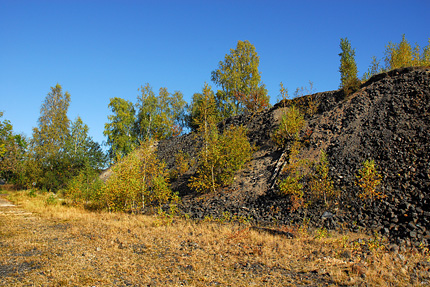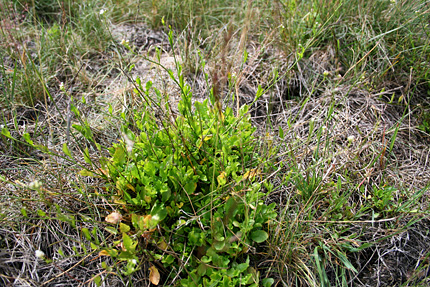Natural variation, underlying molecular basis and ecological role of metal hyperaccumulation in Arabidopsis halleri
Project code: KR 1967/10-2

Heavy-metal contaminated site in Czech Republic. Arabidopsis halleri individuals can be found around the disturbed area.
So-called metal hyperaccumulator plants are capable of accumulating extraordinarily high concentrations of transition metals or metalloids, for example Ni, Zn, Se, As, Cd, Co or Cu, in their above-ground tissues1,2. Discovered in ~500 angiosperm species to date, metal hyperaccumulation is a complex extreme trait of remarkably high occurrence in the Brassicaceae family. Arabidopsis halleri, a stoloniferous perennial and close relative of Arabidopsis thaliana, can hyperaccumulate both Zn and Cd and also shows hypertolerance to these metals. A. halleri was first reported as a colonizer of metalliferous soils and highly disturbed heavy-metal contaminated areas.
The objectives of this collaborative project are:
- large-scale assessment of total leaf concentrations of multiple elements in A. halleri individuals at their natural sites, followed by laboratory-based phenotyping of a large number of individuals grown under controlled environmental conditions. We will thereby analyze the respective contributions of two hypothesized causative factors – genetic diversity and phenotypic plasticity – on natural variation of the leaf ionome in A. halleri, focusing primarily on Cd, Zn and Fe accumulation.
- To work towards an understanding of the molecular mechanisms and genetic basis underlying this natural variation.
- To examine the ecological role of natural variation in Cd and Zn hyperaccumulation in A. halleri with respect to the elemental defense hypothesis.
In order to access the natural variation of metal hyperaccumulation in A. halleri, we have sampled individuals from 85 sites in 8 countries (Germany, Belgium, France, Austria, Italy, Czech Republic, Poland and Switzerland), comprising both non-contaminated and contaminated soils. All field-collected plants accumulated high leaf Zn concentrations, whereas the dynamic range of leaf Cd concentrations was substantially larger, indicating that Cd hyperaccumulation is not a constitutive species-wide trait in A. halleri. There was no correlation between leaf concentrations of Cd and Zn, suggesting that, in contrast to other plants, A. halleri exerts a high level of control over the pathways of movement of each of these metals individually. Moreover, there was no correlation between leaf Cd concentrations and soil Cd concentrations or availability.
Field-collected individuals are now being phenotyped under controlled conditions in the laboratory. All follow-up experiments are taking advantage of previously generated transgenic and newly obtained field-collected A. halleri genotypes exhibiting divergent levels of metal accumulation. To determine the genetic basis underlying natural variation in metal accumulation, we are pursuing candidate gene approaches based on previous results and nucleotide sequence data from individuals at the extreme ends of the dynamic range of metal accumulation3-5. Moreover, we will conduct first steps in preparation of a genetic approach to identify QTL underlying the observed variation. The project is using tools and biological resources which have been developed by our laboratory, including the stable transformation of A. halleri, the upcoming A. halleri genome sequence, an existing 454 transcriptome and RNA-Seq transcriptomic profiles. Laboratory experiments addressing the ecological role of metal accumulation are being complemented by reciprocal transplant experiments between field sites harboring natural A. halleri populations. We will focus on testing the "elemental defense hypothesis". This hypothesis postulates that the high concentrations of metals or metalloids present in leaves of metal hyperaccumulator plants are toxic to pathogens and herbivors and thus serve as an elemental defense, which complements other known defenses consisting of organic compounds and protein biochemical activities6.
To expand the methodological repertoire towards a more profound analysis of metal homeostasis in A. halleri, cell-type specific translatome profiling is being developed by the collaborating group of Professor Dr. Stephan Clemens, University of Bayreuth. Through the contributions of project partner Professor Dr. Caroline Müller, Bielefeld University , to the work addressing the ecological role of metal hyperaccumulation, we will employ local herbivores, feeding experiments with artificial diets, and the monitoring of metabolite fingerprints as well as of metal accumulation and plant herbivory resistance after a first incidence of herbivore attack.

Arabidopsis halleri growing in a heavy-metal contaminated site in Germany (Harz Mountains)
Publications related to the project
Peer-Reviewed Original Research Articles. PI and own SPP employees in bold; cooperation partners within SPP underlined
- Stolpe C, Giehren F, Krämer U, Müller C (2017) Both heavy metal-amendment of soil and aphid-infestation increase Cd and Zn concentrations in phloem exudates of a metal-hyperaccumulating plant. Phytochemistry 139: 109-117


- Stein RJ, Höreth S, Melo JRF, Syllwasschy L, Lee G, Garbin ML, Clemens S, Krämer U (2017) Relationships between soil and leaf mineral composition are element-specific, environment-dependent and geographically structured in the emerging model Arabidopsis halleri. New Phytol 213: 1274-1286


- Suryawanshi V, Talke IN, Weber M, Eils R, Brors B, Clemens S, Krämer U (2016) Between-species differences in gene copy number are enriched among functions critical for adaptive evolution in Arabidopsis halleri. BMC Genomics 17(Suppl 13): 1034; doi 10.1186/s12864-016-3319-5 (22 pages)


- Novikova PY, Hohmann N, Nizhynska V, Tsuchimatsu T, Ali J, Muir G, Guggisberg A, Paape T, Schmid K, Fedorenko OM, Holm S, Säll T, Schlötterer C, Marhold K, Widmer A, Sese J, Shimizu KK, Weigel D, Krämer U, Koch MA, Nordborg M (2016) Sequencing of the genus Arabidopsis identifies a complex history of nonbifurcating speciation and abundant trans-specific polymorphism. Nature Genetics 48: 1077-82


- Krämer U (2015) Planting molecular functions in an ecological context with Arabidopsis thaliana. eLife 4: e06100


- Mandakova T, Singh V, Krämer U, Lysak MA (2015) Genome structure of the heavy metal hyperaccumulator Noccaea caerulescens and its stability on metalliferous and non-metalliferous soils. Plant Physiol 169: 674-89


- Charlier JB, Polese C, Nouet C, Carnol M, Bosman B, Krämer U, Motte P, Hanikenne M (2015) Zinc triggers a complex transcriptional and post-transcriptional regulation of the metal homeostasis gene FRD3 in Arabidopsis relatives. J Exp Bot 66: 3865-3878


- Plaza S, Weber J, Pajonk S, Thomas J, Talke IN, Schellenberg M, Pradervand S, Burla B, Geisler M, Martinoia E, Krämer U (2015) Wounding of Arabidopsis halleri leaves enhances cadmium accumulation that acts as a defense against herbivory. Biometals 28: 521-528


- Muehe EM, Weigold P, Adaktylou IJ, Planer-Friedrich B, Krämer U, Kappler A, Behrens S (2015) Rhizosphere microbial community composition affects cadmium and zinc uptake by the metal-hyperaccumulating plant Arabidopsis halleri. Appl Env Microbiol 81: 2173-2181


- Kazemi-Dinan A, Sauer J, Stein RJ, Krämer U, Müller C (2015). Is there a trade-off between glucosinolate-based organic and inorganic defences in a metal hyperaccumulator in the field? Oecologia 178: 369-78


- Kazemi-Dinan A, Thomaschky S, Stein RJ, Krämer U, Müller C (2014) Zn and Cd hyperaccumulation act as deterrents towards specialist herbivores and impede the performance of a generalist herbivore. New Phytologist 202(2):628-39.


- Mühe EM, Obst M, Hitchcock A, Tyliszczak T, Behrens S, Schröder C, Byrne JM, Michel FM, Krämer U, Kappler A (2013) Fate of Cd during Microbial Fe(III) Mineral Reduction by a Novel and Cd-Tolerant Geobacter Species. Environ Sci Technol 47: 14099-109


- Mühe EM, Adaktylou IJ, Obst M, Zeitvogel F, Behrens S, Planer-Friedrich B, Krämer U, Kappler A (2013) Organic carbon and reducing conditions lead to cadmium immobilization by secondary Fe mineral formation in a pH-neutral soil. Environ Sci Technol 47: 13430-9


- Hanikenne M, Kroymann J, Trampczynska A, Bernal M, Motte P, Clemens S,
Krämer U (2013) Hard selective sweep and ectopic gene conversion in a gene cluster affording environmental adaptation, PLoS Genet 9(8): e1003707).






